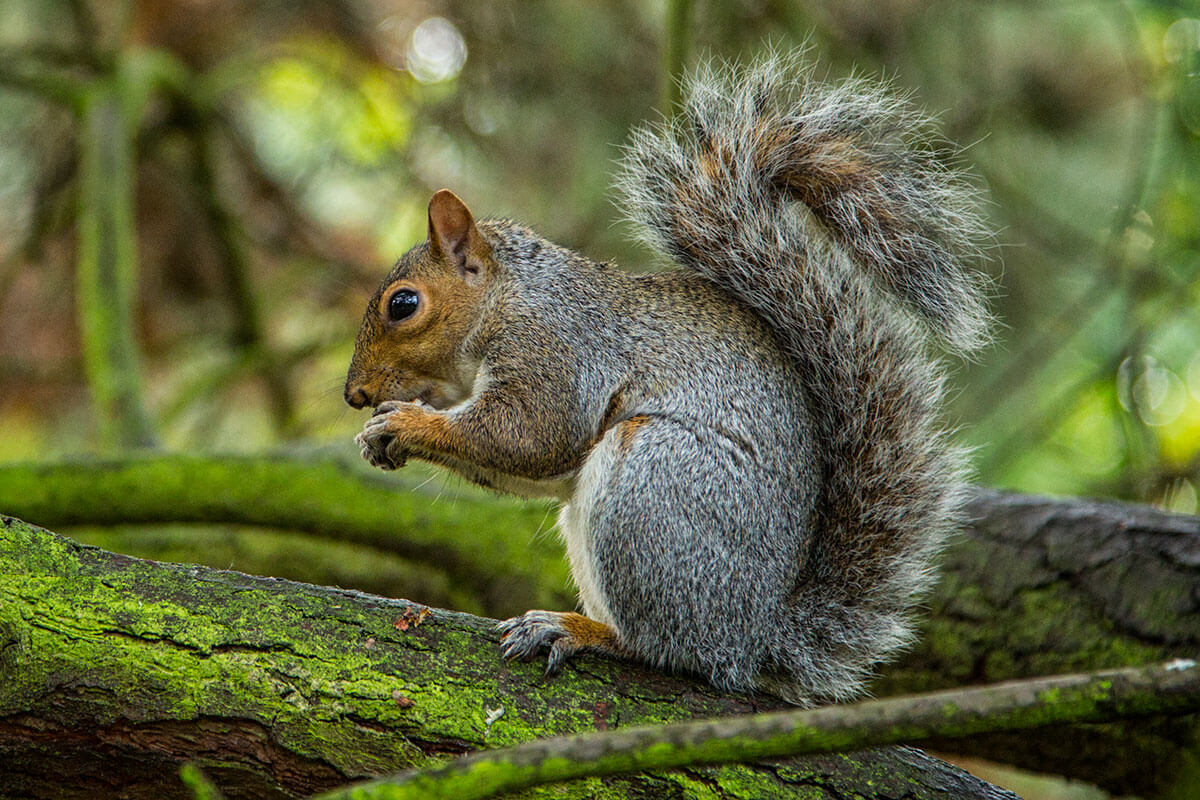Gray Squirrels

Gray squirrels are the most common species of squirrel in North America. Their most familiar trademark is a bushy tail that is used for balance, warmth, shelter, communication and as a parachute. The gray squirrel weighs about 1 ½ pounds and is 14 – 20 inches long, including its tail which measures 5 – 10 inches. Fur is a mixture of dark to pale gray with reddish brown tones. The ears and tail are pale gray to white. Their underparts are usually buff colored.
Grays are members of the rodent family, and are one of about 230 species of squirrels. These familiar animals are found in the eastern United States, just west of the Mississippi River and north to Canada. They also thrive on every continent except Antarctica and Australia. Gray squirrels have existed for some 350 million years. Worldwide, various species range from the tiny 5-inch long pygmy squirrel of Africa to the 3-foot long giant squirrel of Asia.
Squirrel Facts & Features
- Gray squirrels live in trees located in forests, parks and backyards.
- They were originally a source of food for predators such as foxes and raptors as well as for people; many people hunt and eat squirrels.
- Squirrels usually maintain two sets of quarters. One is inside a tree; the other is in a nest of leaves and twigs positioned on a tree crotch 30 – 45 feet above the ground.
- Their diet is vegetarian, comprising of nuts, seeds and buds; they sometimes eat insects and frogs.
- In late summer squirrels store nuts and seeds to feed on through the winter, when food is scarce.
- In winter the animals feed on corn and wheat, if available.
- Ground squirrels hibernate; tree squirrels do not.
- Squirrels eat the equivalent of their body weight in food (about 1 ½ pounds) every week.
- Male and female gray squirrels are similar in size and color.
- Squirrels are very athletic and can drop as far as 100 feet without being hurt.
- Hind feet are nearly 3 inches longer than forepaws.
- Long, sharp claws dig into tree bark, providing extra traction.
- Adult squirrels have 22 teeth.
- Eyes are positioned to see nearly 360 degrees.
- Black squirrels are more suited to colder temperatures because they lose 18% less body heat than their lighter counterparts.
Parenthood
Squirrels are prolific breeders and may produce as many as eight offspring twice a year. The animals breed in the winter, from December until February, and again in late spring through May and June. After a 44-day gestation period, they produce an average litter of 2 – 4 babies. Newborn squirrels are hairless and weigh just ½ ounce. Their average lifespan in the wild is 13 years.
When to Watch
Squirrels are most active in spring, summer and fall, with females more active in summer and males in winter. They are busiest two hours after sunrise and two to five hours before sunset, so they can avoid the hottest part of the day. During the winter, squirrels come out of their nests for just a few hours late in the afternoon.
For people of all ages, squirrels are entertaining to watch (second only in popularity to birds). They are very acrobatic and perform amazing-looking feats in trees and on wires, clotheslines and fences.
Squirrels bury food in what looks like a disorganized manner called scatter hoarding. Later, they locate their stash through memory and smell. This stashing of food for the winter is literally a form of planting trees, an activity that plays a crucial role in ecology.
Rodents are known for their personal cleanliness, and male squirrels are considered to be the cleanest members of the rodent family.
Helping Orphaned Squirrels
Baby squirrels are very fragile. If you find an orphan, it is important to get it back to its mother as quickly as possible. If this is not possible, contact a park ranger or campground personnel
Beware!
Remember, squirrels are wild animals. Teach your children to beware of all animals in the wild and to avoid any creature that is acting strangely, including one that seems unusually friendly. Wounded animals can be very dangerous! If you find one, call a conservation officer or veterinarian. Also, keep your pets away from wild animals, especially those acting sick or running towards, rather than away from, you. If you are bitten by a wild animal, try to capture it so your veterinarian can analyze it for rabies. This can be done whether the animal is dead or alive. If you cannot find the animal, you may need to undergo rabies prevention treatment.
References
- The University of Michigan Museum of Zoology Animal Diversity Web
- Encarta Online Deluxe
